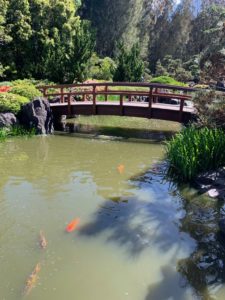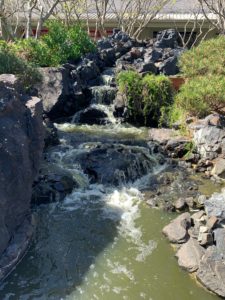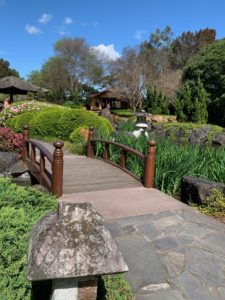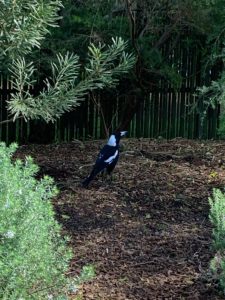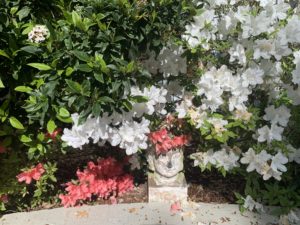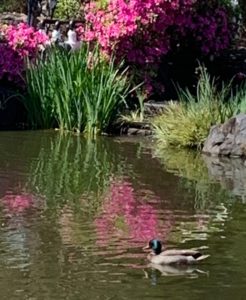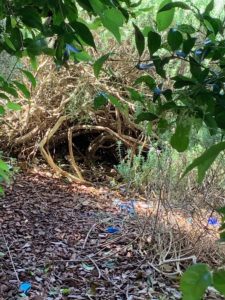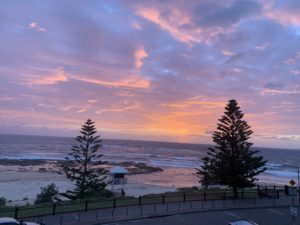


Celebrating the Olive Pink Extraverganza: Revealing a woman ahead of her time,
with garden tours, local plants sales, poetry readings, art, music, book launch, dinner under the stars, World renowned Riley Lee playing his shakuhachi the Japanese bamboo flute with his circular breathing gives us pause to stop . . . draw breath
for the world premiere of Professor Anne Boyd’s Opera based on a day in the life of this amazing visionary.

Together on Arrernte country
a garden a meeting place
a desert oasis
on Caterpillar Dreaming
from all across the land
an artist a poet composer
and writers come together 
to walk read play music and share
their story found in the visionary
and activist Olive Muriel Pink
her voice for Aborigines
dispossessed of their land
their lore their sacred soaks
silenced in her life time
now sings and dances
in her arid garden
planned with her cartographer’s eye
with water-wise rocky channels gutters
ponds troughs mulch
and terrarium effects
encouraging her 600 ‘gallant ones’ *
with havens for bird song
taming the razor earth
for seed like one cracks lithic earth
breaks flint for life to birth
along rock paved paths we track
up the Hill to sit and watch
the setting sun caress the nose
of the giant Dingo
Alhekulyele keeping watch
from the beginning of time
in a palette of moody cloud
and glint of light on schist
dancing to a subtle world
that echos in the harmonics 
of sharp brittle quartzite
softened by waves of mulga
with hum in hot and humid air
bonsai-like trees stunted by flinted soil
even the desert sun is curbed
by slanted shades of green
every leaf dimmed and curled
for protection
a landscape that lures with music
singing the creation
of every rock leaf every insect
and on red desert rock
a dragon goanna suns itself
head held high with ancient knowing 
we are but travellers here
our solemn response
poetry art stories and a world premiere
of an Opera ‘a day in the life of Miss Pink ‘
a woman dismissed put down
silenced suppressed and stifled
now a young spirit woman sings
and dances with bird and tree and rock
across the garden
opening another crack
in the great Australian silence
birthing a deeper knowing
of who we are.
- Arid vegetation that live with less than 13’ of rainfall a year
- a;-kool-ya Mt.Gillen

Thursday September 28TH DAY 1


And we are lured by this primordial music Olive Pink Extravaganza
at least we come easier than Miss Pink in her day
her dusty rattled train called the Ghan
took days . . .
we traversed hundreds of kilometres
in a few hours above breathtaking
orange, red, rocky, salty patches,
meandering rainbow serpents
traces of river beds
and wonderful mirages
with illusions of an inland sea
to meet kindred spirits
and with books opera art poetry
song plants bush medicine and story
of the elders and story of
the newly inspired
we are thrilled to have our hired car and Desert Palms Resort
cabin for the next 10 days.









Friday 30th September 2022 Day 2
9am
The Olive Pink Art show . .. we offered to help set up
arriving in the garden it broke the ice to meet everyone and the story began.
Garden walks, music, art ,poetry, a rock wallaby grazing with its baby
half out of its pouch mimicking it mother with head moving up and down,
our dragon goanna sitting on top of a rock the thousands shades of greens
and the rock, their structure, textures and pallets of colour
and the landscape, always changing in the ever changing light.
Back at our pad for a rest and back by 3pm to go on a botanist walk with the famous Peter Latz.
After that Michael and I went for a walk to plan for Thursday if I have to do it by myself.
5.30
We went to the opening of the Art Show on Olive Pink by Cheryl Kensett and her friend Jane was a lovely meeting for us as we felt kindred spirits on our journey and for Cheryl on our an adventure. The woman who opened the show said that their parents were introduced to each other by Miss Pink and on a special occasion Olive Pink entertained them with her famous white china.




Saturday 1st October DAY 3 launch day
2pm
Olive Pink and her garden walk. We set out with about 15 people with Anne Boyd, Gillian Ward and the curator Ian Colman. It was interesting to find out more and amore. Every time we walk we find new colour, new light , texture , smells animals . Today the main birds were an amazing silver-green winged parrot. And lots of warblers that live in families. Later Michael and I sat entertained by two courting galahs on a lower branch of a superb ghost gum.
4pm
Back from our walk we waited for the elders who knew Olive and had stories to tell,. They arrived slowly . . . Josie Petrick, (98) OAM. A husband and wife who wee introduced by Olive Des and Pat Nelson, , an indigenous woman who lived in town who knew Olive . . each took the mic and told us many fun stories.

5.30 My launch
Acknowledgement to country by Ian Coleman,
Introduction of Anne Boyd by Michael Keating
Professor Anne Boyd Launch of book
Colleen Responds with thanks and reads three poems ( this will be available to read on another page – –Olive Muriel Pink
Eden sings his created song inspired by Olive
World renowned Riley Lee with his shakuhachi plays music including 2 antiphons composed by Hildegard of Bingen! and several traditional pieces.




The music was Riley Lee playing the Japanese Flute called the Shakahati and the moment of serendipity was when he said he chose music of another strong spirited woman he felt connects with Miss Pink even though she comes from another world and that was Hildegard of Bingen.
7pm
Dinner Under the stars. Panel introduced and hosted by Clare Kincliff
Miss Pink from Obscurity to Centre Stage.
An artist discovering Miss Pink – Cheryl Kensett, the Opera Composer Professor Anne Boyd, writer and curator Gillian Ward, and myself poet Colleen Keating.



Sunday 2nd October DAY 4
11 am


A poetry walk. This was with Ian Coleman , Anne Boyd and myself. It was very small, a really nice woman joined us called Gae, a local woman who has several times gone out to talk with Olive at the cemetery and she enjoyed our walk and my reading of some poems along the way and bought my book .
At 1.30 we went into the Red Kangaroo Book Shop to hear Cath Bishop talk on her book about Annie Lock , an amazing story of another amazing woman.
We came home and had a rest .
Back to the garden for a talk with Cheryl about her paintings on Olive and her other two exhibitions which she shared via slides Dancing Miss Pink and Seeds.
A sunset walk with Ian, Anne and Connie a past very well informed gardener and about 10 visitors . I read a poem along the way.
And sold three more books.




A VISIT TO RED KANGAROO BOOK SHOP IN THE CENTRE OF ALICE SPRINGS TOWN
SO EXCITING AND PROUD TO SEE MY BOOK OLIVE MURIEL PINK IN THE FRON WINDOW AND ON THE SHELVES.





Monday 3rd October DAY 5
Spring walk
Finally a rest day with a walk around the garden at 3pm and enjoyed the spring colour .
All the little wildflowers many of them in the memory of the soil are recovering
What vision Miss Pink had and here it is coming to fruitition.












Tuesday 4th October DAY 6
my plan is a walk in the garden.
a visit to the Art gallery
and a sunset visit to Olive Pinks grave site.
My most special thanks goes to Michael
He is home to me
And this past 10 days our pilgrimage, our journey, our advaenture
could not have been taken without Michael by my side
-
- Setting out 2. Settling into the garden 3. Update




Launch of Olive Muriel Pink
BUSH MEDICINE WORKSHOP IN THE OLIVE PINK BOTANIC GARDEN
It was very special to join with a group of Arrernte women and children as they set up for a Bush Medicine Workshop .
Bush medicine refers to ancient and traditional Aboriginal botanicals for the use of physical and spiritual healing that has been in practice for thousands of years. They had three medicines available
one to sootheand nurture dry skin,
one to soothe joint and muscle joints
another a chest rub for colds and flu and to relieve breathing in congestion
I cant remember which we were preparing at the workshop nut it was very informative.







Plant sale what a wonderful event. Olive Pink would be thrilled. It was like a boxing day sale a long queue at 7.30 in the morning to buy tiny propagrated seeds of the arid native plants for the area. Imagine the work done in the garden spreading out making a native garden of the whole of Alice Springs.



OPENING OF THE OLIVE PINK ART SHOW BY CHERYL KINSELL


TUESDAY 4th October DAY 6
ARALUEN ART & CULTURE CENTRE, TELEGRAPH STATION, CEMETERY, ANZAC HILL FOR SUNSET
Tuesday Today we went to the Araluen Art Centre and stood before 13 original Albert Namatjira
paintings and many others from the Hermannsburg Painting School . Then we enjoyed an exhibition called The Desert Mob.It was a lovely art Gallery and an enjoyable visit.
Next we drove out to the Telegraph Station. We had our water and muesli bar and noticed in messages Elisabeth was awake so I rang her as Michael walked out onto the dry Todd River to search out the tiny spring hidden It was miniature smaller than a garden pond but there was about 50 little birds flitting around the water and then flying back to a tree high on the rocky outcrop .
We came home and had a rest and then as the sun was setting we headed out to visit Olive Pink’s grave site . Michael captured a photo of me sitting by Olive and the beams of light shine down as the sun was sitting,



 Albert Namaatjira 1902 – 1959 Finke river MacDonnell Ranges 1936
Albert Namaatjira 1902 – 1959 Finke river MacDonnell Ranges 1936




Teleegraph Station :A sculpture of tree and rosck . One could never create the beauty of this.

 MY FAVOURITE PHOTO
MY FAVOURITE PHOTO
Olive Pink facing west to watch forever the setting sin over Mt Gillen


Anzac Hill just to finish off the day
WEDNESDAY 5th October DAY 7
REST DAY: DRIVE OUT OF TOWN STANDLEY CHASM AND SIMPSONS GAP
What an amazing morning Michael and I had. We set out early and on the spur of the moment decided to drive further out to Standley Chasm first and then fold back later in the morning to walk into Simpsons Gap. The idea was to miss the bus loads of tourists who come to be in the chasm around about midday to see the sun fill it with the light to make the rock fiery red. As I hoped by going early we might miss the crowds.











STANDLEY CHASM ANGKERLE ATWATYE
THIS IS AN IMPORTANT CULTURAL PLACE OF INDIGENOUS AUSTRALIA. IT IS SACRED TO WOMEN’S DREAMING OF THE ARRERNTE PEOPLE.
It was about a 20 min walk along a dry river track winding upwards toward the chasm . The rock that were closing in around us was a stunning red /orange/black / cracked along fault lines piled on and on just stunning . We loved the trees mostly ghost gum spectacularly white trucks but even with a variety of colours when you take time to look. What made us smile many of them growing sideways . Michael had to watch his head as the trunks canopied the track. Some of the trees caught our attention in the way they had found a symbiosis with the rocks.
We entered slowly into the chasm realising the sacred and feminine place it is .
There was one bus load of school girls ahead of us with a guide. So our entry into the chasm was full of chatter They took a group photo and chattered on and slowly moved back down and out and a silence fell in the whole chasm.we got half an hour by ourselves . Just sitting and listening and looking and being full of awe and wonder in an amazing silence.Then came a couple who nodded to us and sat and she whispered to the man it was spellbinding . High on the red rock were a few small ghost gums standing tall and spectacular stands of bright white Flannel Flowers. Only a small amount of water at the top end but the reflections we played with were very satisfying.
Then the groups started to trickle in and the noise picked up Admittedly when we got back down many buses had arrived and campervans were there and they were taking their time having morning tea for the big foot traffic is midday or 11.30 when the sun comes thru and lights it up but I much preferred the peace rather then a crowd and the red light.
We walked back very slowly lingering along the way and in the car and trekked back to Simpson’s Gap .
We were not alone but the small groups were quiet and with the red rocks their colour and texture , with the white sand, the ghost gums and river gums their bulbous roots digging down into the dry river beds , the purple flowers that fanned our path , the salty grey bush and and black thorny bush and the flowers and small bushes that seem to live on rock including the few trees whose roots climb down the rock in search of crack to root in it was a time of breathtaking scenery.
THE SIMPSONS GAP.
A 15 min walk along a sandy dry river with amazing trees that survive . Loved the No Swimming sign.
The drive back to Alice was interesting again as the sun had changed and the light on the Caterpillar Range was astounding.







 Back home for a rest and sandwich and coffee.
Back home for a rest and sandwich and coffee.
Thursday 6th October Day 8
POETRY READINGS IN THE GARDEN WITH A TOURIST GROUP HERE FOR OPERA
REFRESHING SWIM BACK AT DESERT PARK
TROUBLESOME WOMEN FORUM
An interesting day unfolded.It was our hottest day so far. It seemed a bit like overwhelm to begin with . Ingrid from Galah Journal had got in contact with me via Kangaroo Books wondering if I would have time to give to her 25 people arriving from all over Australia as they would not come to my poetry reading on the Friday. So today we drove to the Mecure and met Annabelle, the editor of the Galah Journal and walked them along the path and into the garden where I showed them some features and at differnt shady spots we read poetry.They were young and excited and didn’t seem to notice the heat. They loved the experience, amazed at the garden and even more excited to be attending the opera on the Friday night. They were an enthusiastic group all subscribers to Galah gave them a communalityand many meeting for the first time and their enthusiasm was infectious.





Afterwards a very happy walk around the garden reading poetry we decided to take advantage of our Desert Park R esort and had a most refreashing swim.



We were so lucky we chose this accomodation, walking distance to the garden, on the Todd and quite a resort




At 4.30 we made our way out to the Aviation Museum which was the chosen venue for the Forum
Troublesome women.
I had been invited weeks before on email to represent Olive Pink. It seemed so far in the distance I said yes olf course and now it was a reality to be faced and conquered,
Fortunately I had prepared a paper which I will put on the Olive Pink page . The other speakers were Dr.Eleanor Hogan who had written about two fiesty women of the outback Daisy Bates and Ernestine Hill and Dr. Cath Bishop who had written a very authoritive book on a Missionary called Annie Lock.
The venue acquired was the Aviation Museum and it was packed maybe 80 people up the stairs of an areoplane even .
It turned out to be great fun and The Red Kangaroo Book Shop were there with lots of my book and I sold quite a few of my book to people wanting to know more about Olive.







Friday 7th October Day 9
BREAKFAST IN THE GARDEN TO MEET OUT PHILANTROPIST FOR THE OLIVE PINK OPERA
LUNCHTIME POETRY READING AND STORY OF MISS PINK AT RED KANKAROO
OPERA IN THE GARDEN
This morning we were invited to breakfast in the garden with all the Olive Pink Glitterti and especially to meet Julie Marcus, the Anthropologist who uncovered Olive Pink from the silent forgetting of women anthropologists of the 1930’s and 40’s. and to meet Pam Usher, the very generous philanthropist who had just flown in from Melbourene. Without her generosity the Olive Pink Extravaganza and the Olive Pink Opera could not have been staged to the very high stndard it is and consequently my book would not have been launched and given the high profile it has received . So Michael and I were invited to order breakky and enjoy this Olive Pink moment.
Anne Boyd (composer) and her partner David, Cheryl Kensett (artist) and her friend Jane, Gillian Ward (writer and curator of Olives paintings ) Julie Marcus (Anthropologist and writer)and her partner Andie, Ian Coleman the Curator of the park and our special guest Pam User who has made outr coming together possible.

12.00 We spent the next hour and a bit at The Red Kangaroo Bookshop. I gave a prepared 6 min talk adjusted from my SWW talk about Olive. And then we had a wonderful warm chat with questiona and I read poems from the book to help tell the Olive Pink story.




4.30 we were back in the garden for the Opera. I was so excited allmy committment were over and now I could relax and enjoy. We were included in the VIP group free champas, finger food and a few talks from Anne and we as the Glitterata were introduced to those who had paid $198 to meet Anne Boyd the composer and all of us.
Before the opera.
Anticipation had been building all week. The ground was levelled and smoothed. We saw the hugh truck arrived to deliver the seating and stage. The next two days it was built . The set was erected with the tent for Olive and the sheets hanging on her line. There were sound and lighting worked on . Musicians were practicing, a dress rehearsal made the garden a haven of activity colourful costumes for the elders






 .
.
3 50 pm. Michael and I arrived and sat in the gaden so we were parked with our car there. Most were bused in after parking at the Convention Centre.
An ambulance arrived and parked . The catering arrived to set up . Musicians and singers trickled in and then the first bus load arrived and action was on . There was picnic boxes and champayne for sale and a real buzz began. Michael and I joined the VIP group who had paind extra for free champas and nibbles and to meet the composer of the Opera and all of us. Anne said a few words about the Opera and we sold quite a few books.
5pm VIP party begore the Opera










Amazing evening. A highlight of my Olive Pink journey. It was hard to believe I was part of this evening of an opera in her garden.My favourite scene after Olive had finished her life’s work

from my poem, Dangerous Miss Pink.
As Olive walks away with her Warlpiri gardener, Johnny Jampijinpa Yannarilyi
‘I used every means with pen and ink
to bring injustice to public attention
and keep it to the fore.’
Her lips curl. A hesitant smile.
‘They called me dangerous.’
He levels out some of the stones.
They sit ahile in the stillness.
She turns, puts her hand on his arm ,
‘The garden is glorious.
I am leaving. But you must stay,
and insist you keep getting proper pay’
They walk further
sit on a chiselled stone seat
and watch the colours on the hill
as the sun begis its journey home.

A moment of union and cameraderie of the three writers who have researched and written about Olive Pink,
from left: Colleen Keating : Olive Muriel Pinl: her radical and idealistic journey.
Gillian Ward: Olive Pink : artist, activist & gardener : a life in flowers
Julie Marcus: The Indomitable Miss Pink (from Anthropology point of views.)
Farewell to the Red Centre : from our flight home




